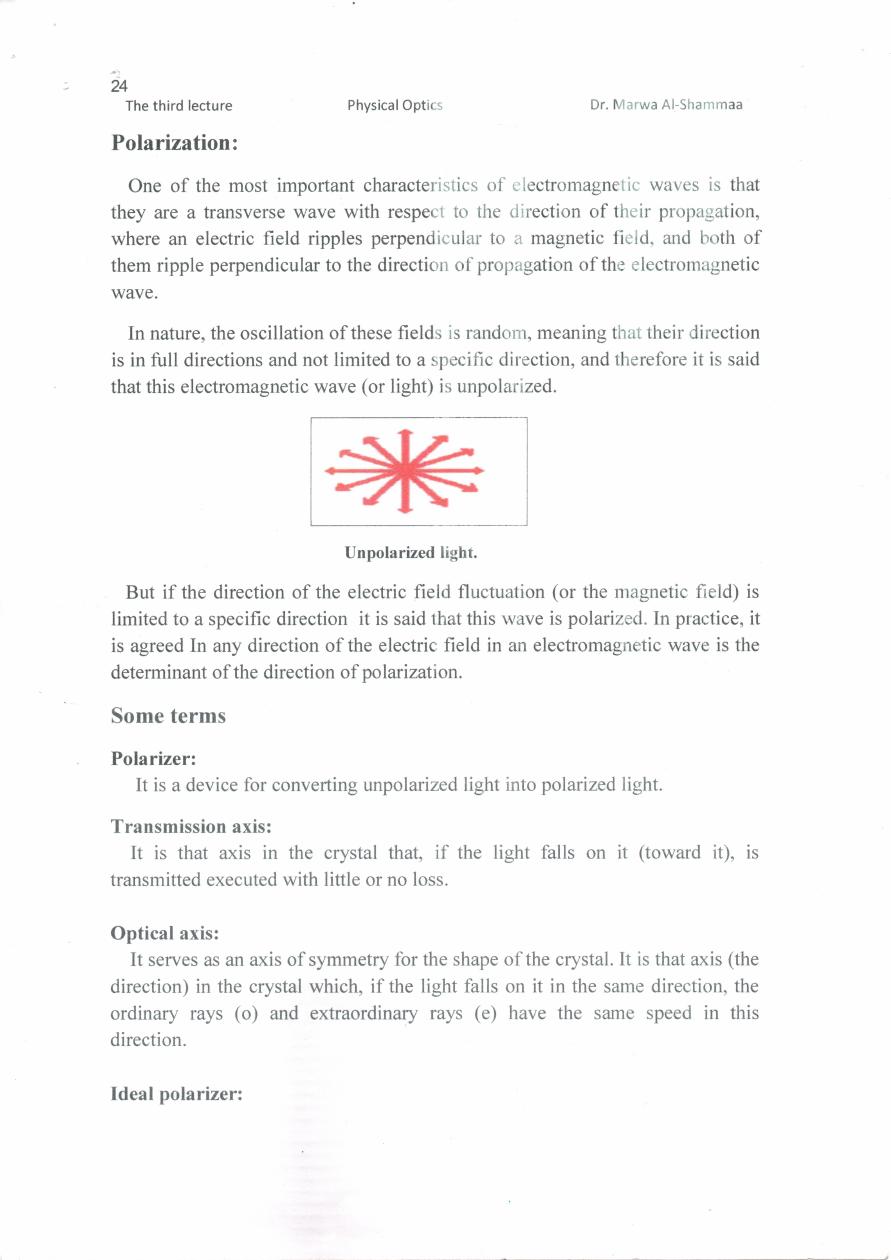
24
The
third lecture
Physical
Optics
Dr.
Marwa Al-Shammaa
Polarization:
One
of
the most important characteristics
of
electromagnetic waves
is
that
they
are a
transverse wave with respect
to the
direction
of
their propagation,
where
an
electric field ripples perpendicular
to a
magnetic
field, and
both
of
them ripple perpendicular to the direction
of
propagation
of
the
electromagnetic
wave.
In nature, the oscillation
of
these fields
is
random, meaning that their direction
is in full
directions and not limited
to a
specific direction, and therefore
it
is
said
that
this
electromagnetic wave
(or
light)
is
unpolarized.
Unpolarized
light.
But
if
the direction
of
the electric field fluctuation (or the magnetic field)
is
limited to
a
specific direction
it
is
said that this wave
is
polarized.
In
practice,
it
is
agreed In any direction
of
the electric field
in an
electromagnetic wave
is
the
determinant
of
the direction
of
polarization.
Some
terms
Polarizer:
It
is
a
device for converting unpolarized
light into
polarized
light.
Transmission
axis:
It is
that
axis in
the crystal
that,
if
the
light
falls on
it
(toward
it),
is
transmitted executed with
little or no loss.
Optical
axis:
It
serves as an axis
of
symmetry for the shape
of
the
crystal. It is
that
axis (the
direction)
in
the crystal which,
if
the light
falls on
it
in
the
same
direction, the
ordinary
rays (0)
and extraordinary
rays (e)
have the
same
speed
in
this
direction.
Ideal polarizer:
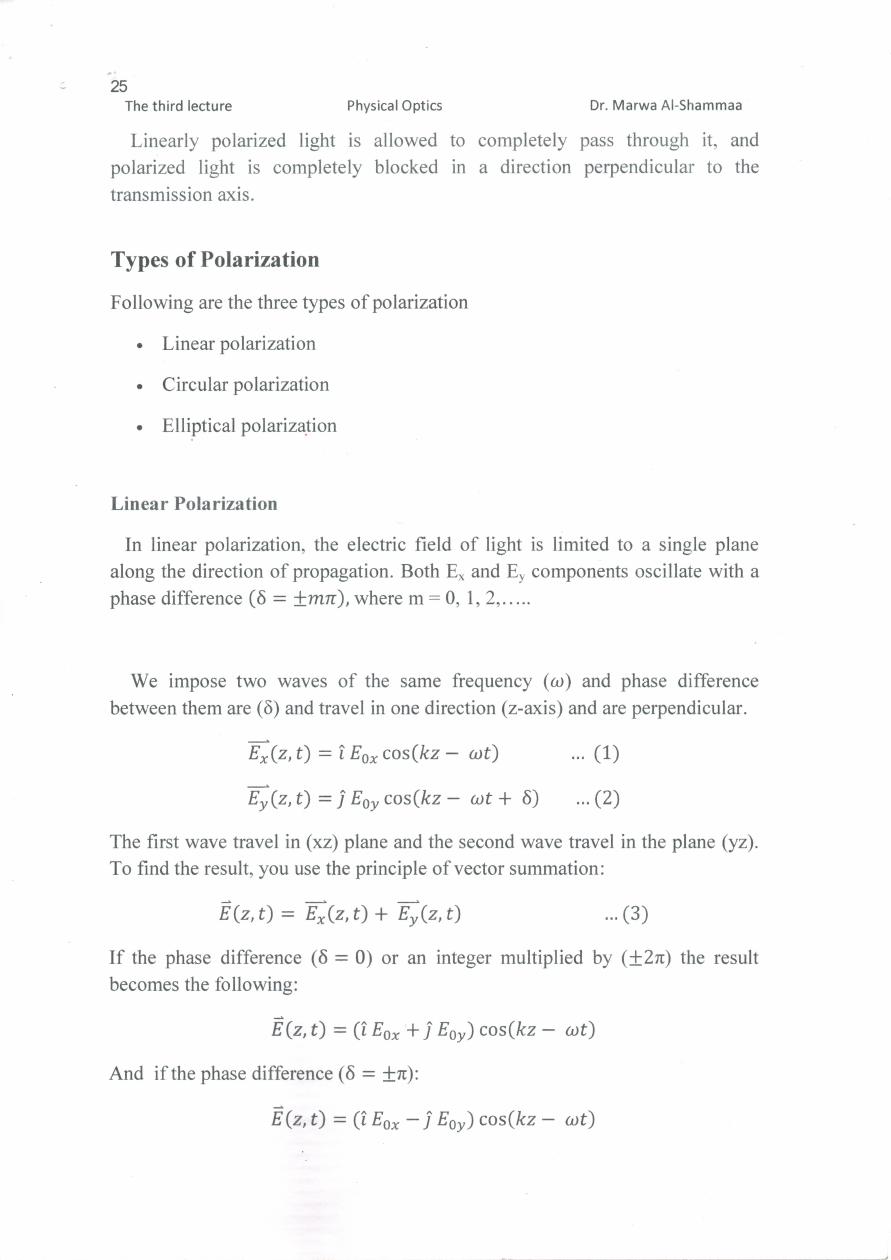
Se
|
The
third lecture
Physical
Optics
Dr.
Marwa Al-Shammaa
Linearly polarized light
is
allowed
to
completely pass through
it, and
polarized
light
is
completely blocked
in
a
direction perpendicular
to
the
transmission
axis.
Types
of Polarization
Following
are
the three types
of
polarization
«
Linear polarization
«
Circular polarization
-
Elliptical polarization
Linear Polarization
In linear polarization, the electric field
of
light
is
limited to
a single
plane
along the direction
of
propagation. Both
E,
and E; components oscillate with
a
phase difference (6
=
mm),
where
m=0,
1,
2,.....
We
impose two waves
of
the
same
frequency
(w)
and phase difference
between them
are (0)
and travel
in one
direction (z-axis) and
are
perpendicular.
E.(z,t) =1
Ey,
cos(kz
—
wt)
..
(1)
E,(z, t)
=
Jj
Egy
cos(kz
—
wt +
0)
..(2)
The
first wave travel
in (xz)
plane and the second wave travel
in
the plane
(yz).
To
find the result, you
use
the principle
of
vector summation:
E(z,t)
=
Ex(z,t)
+
E,
(zt)
(3)
If
the phase difference
(6
=
0)
or
an
integer multiplied
by
(Z+2n)
the result
becomes the following:
E(z,t)
=
(Egy
+]
Eyy)
cos(kz
—
wt)
And
if
the phase difference
(6
=
+n):
E(z,t)
=
GEyy
—
J
Ey)
cos(kz
—
wt)
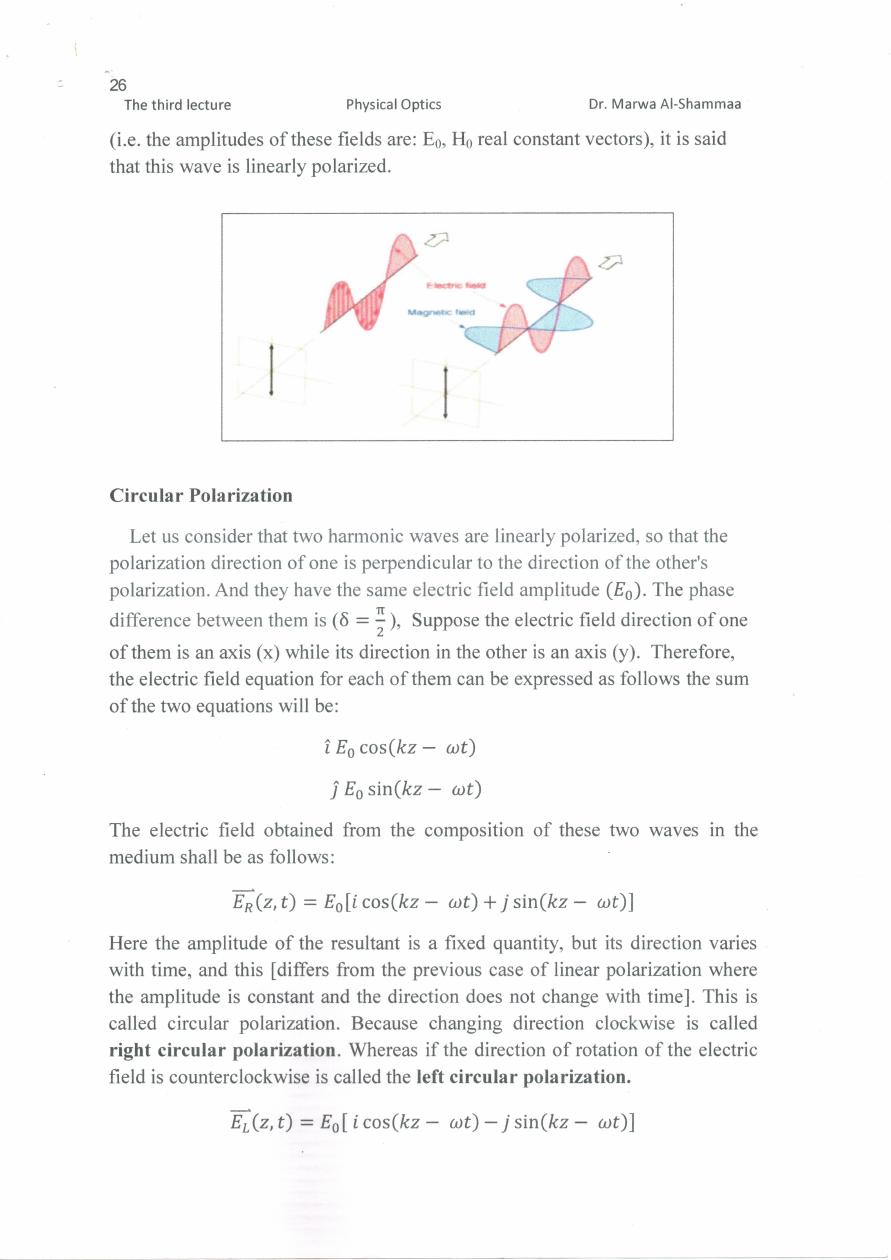
26
The
third lecture
Physical
Optics
|
Dr.
Marwa Al-Shammaa
(i.e. the
amplitudes
of
these fields
are:
Ey, Hy
real constant vectors),
it is
said
that
this
wave
is
linearly polarized.
Circular Polarization
Let
us
consider that two harmonic waves
are
linearly polarized,
so
that
the
polarization direction
of
one
is
perpendicular to the direction
of
the
other's
polarization. And they have the
same
electric field amplitude
(E,).
The phase
difference between them
is
(6
= =),
Suppose the electric field direction
of
one
of
them
is an axis (x)
while
its
direction
in the
other
is
an axis (y).
Therefore,
the electric field equation
for each
of
them can
be
expressed
as
follows
the
sum
of
the two equations
will be:
1
Eycos(kz
—
wt)
j
Eysin(kz
—
wt)
The electric
field
obtained from the composition
of
these two waves
in the
medium shall
be as
follows:
Er(z, t)
=
Eyglicos(kz
—
wt) +
jsin(kz
—
wt)]
Here the amplitude
of
the resultant
is
a fixed quantity, but
its
direction
varies
with time, and this
[differs
from the previous case
of
linear polarization where
the amplitude
is
constant and
the
direction does not change with time]. This
is
called circular polarization. Because changing direction clockwise
is
called
right circular polarization.
Whereas
if
the direction
of
rotation
of
the electric
field
is
counterclockwise
is
called the left
circular polarization.
E,
(z,
t)
=
Eyl
icos(kz
—
wt)
—
jsin(kz
—
wt)]
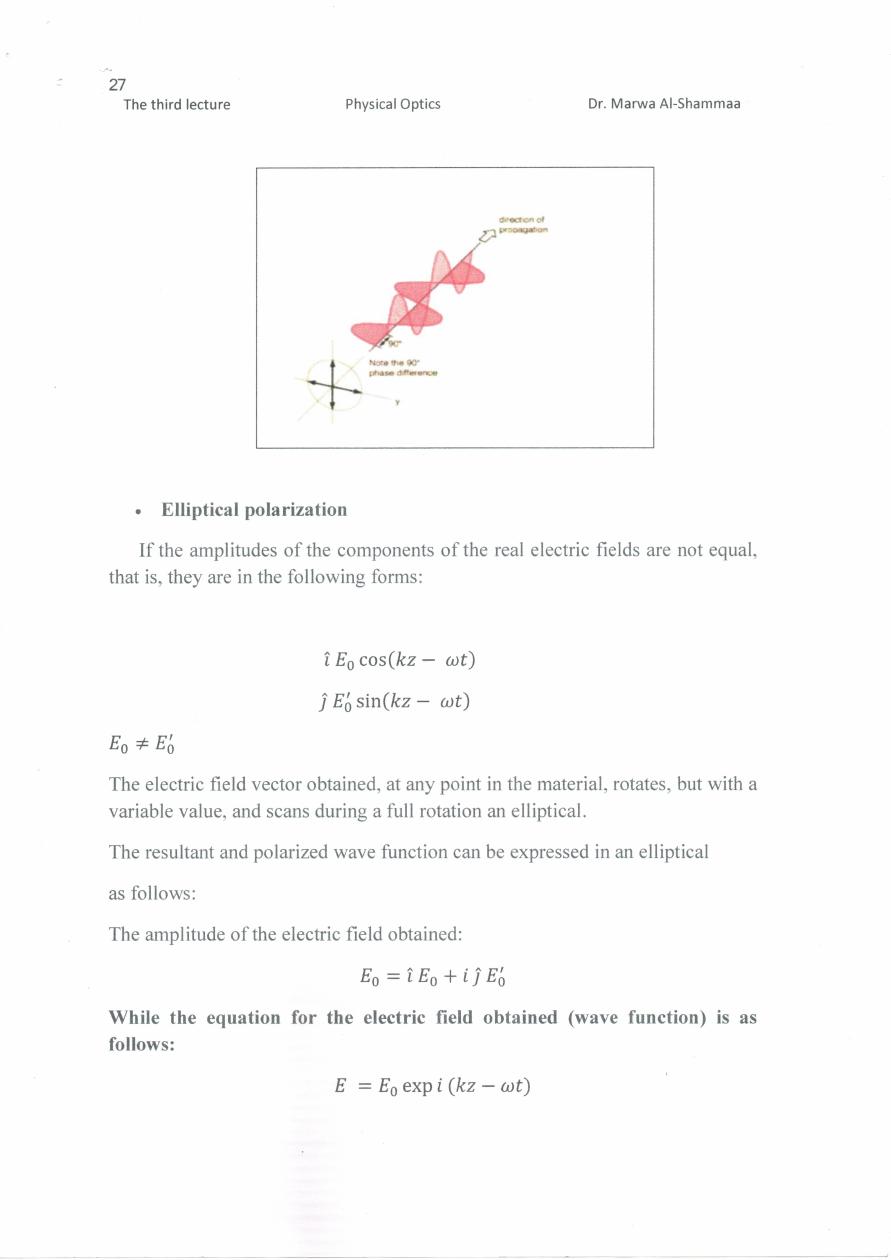
27
The
third lecture
Physical
Optics
|
Dr.
Marwa Al-Shammaa
«
Elliptical polarization
If
the amplitudes
of
the components
of
the
real
electric
fields are
not
equal,
that
is,
they
are in the
following
forms:
i
Eycos(kz
—
wt)
j
Eysin(kz
—
wt)
E,
#
E,
The electric
field
vector obtained,
at
any point
in
the material, rotates, but with
a
variable value,
and
scans during
a full
rotation
an
elliptical.
The resultant and polarized wave function can
be
expressed
in an
elliptical
as follows:
The amplitude
of
the electric
field
obtained:
Eo
=1E,+ijE,
While
the equation for the
electric field
obtained
(wave
function)
is
as
follows:
E
=Ejexpi(kz
—
wt)
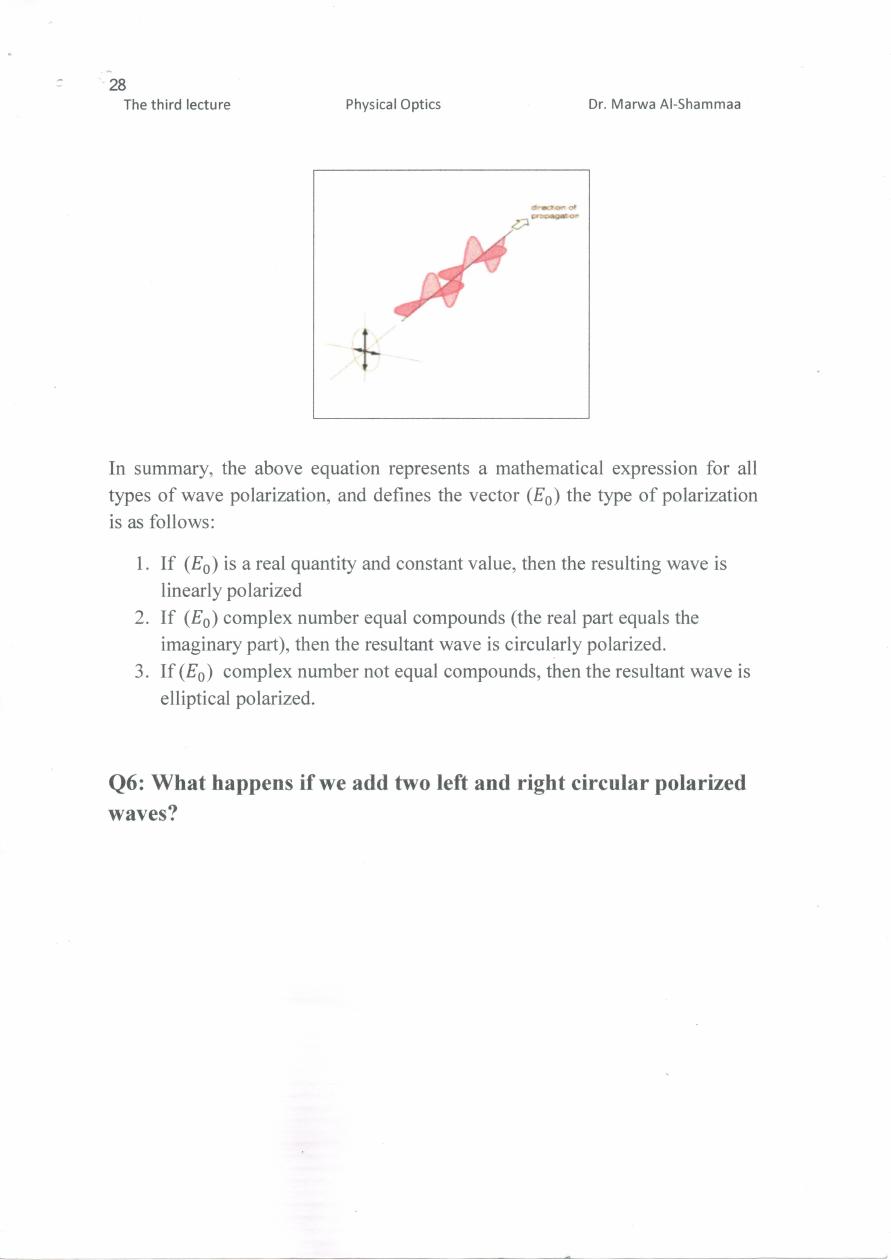
28
The
third lecture
Physical
Optics
Dr.
Marwa Al-Shammaa
In summary, the above equation represents
a
mathematical expression for
all
types
of
wave polarization,
and
defines
the
vector (Ej) the type
of
polarization
is
as
follows:
1.
If
(Ey)
is
a
real quantity
and
constant value, then the resulting wave
is
linearly polarized
2.
If
(Ey)
complex number equal compounds
(the real
part equals
the
imaginary part), then
the
resultant wave
is
circularly polarized.
3.
If
(Ey)
complex number not equal compounds, then the resultant wave
is
elliptical polarized.
Q6:
What happens
if
we
add
two left
and right circular polarized
waves?
